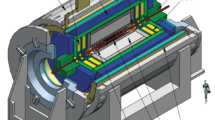Abstract
Strangeness production in heavy-ion collisions is one of the main goals of the scientific program at the NICA accelerator complex. The MPD detector is designed to study the properties of strongly interacting matter at extreme baryon densities. In this article, the MPD performance to measure the excitation function of the strangeness to entropy ratio in central Au + Au collisions is reported. The investigation has been performed at the Laboratory of High Energy Physics, JINR.















Similar content being viewed by others
REFERENCES
Y. Aoki, G. Endrodi, Z. Fodor, S. D. Katz, and K. K. Szabo, “The order of the quantum chromodynamics transition predicted by the standard model of particle physics,” Nature (London, U.K.) 443, 675 (2006).
J. Berges and K. Rajagopal, “Color superconductivity and chiral symmetry restoration at non-zero baryon density and temperature,” Nucl. Phys. B 538, 215 (1999).
V. D. Kekelidze, R. Lednicky, V. A. Matveev, et al., “Three stages of the NICA accelerator complex,” Eur. Phys. J. A 52, 211 (2016).
V. Golovatyuk, V. Kekelidze, V. Kolesnikov, et al., “The multi-purpose detector (MPD) of the collider experiment,” Eur. Phys. J. A 52, 212 (2016).
C. Alt et al. (NA49 Collab.), “Pion and kaon production in central Pb + Pb collisions at 20A and 30A GeV: Evidence for the onset of deconfinement,” Phys. Rev. C 77, 024903 (2008).
B. I. Abelev (STAR Collab.), “Enhanced strange baryon production in Au + Au collisions compared to p + p at √s(NN) = 200 GeV,” Phys. Rev. C 77, 044908 (2008).
W. Ehehalt and W. Cassing, “Relativistic transport approach for nucleus nucleus collisions from SIS to SPS energies,” Nucl. Phys. A 602, 449 (1996).
A. Palmese, W. Cassing, E. Seifert, et al., “Chiral symmetry restoration in heavy-ion collisions at intermediate energies,” Phys. Rev. C 94, 044912 (2016).
K. U. Abraamyan et al. (MPD Collab.), “The MPD detector at the NICA heavy-ion collider at JINR,” Nucl. Instrum. Methods Phys. Res., Sect. A 628, 99 (2011).
J. Aichelin, E. Bratkovskaya, A. le Fevre, et al., “Parton-hadron-quantum-molecular dynamics (PHQMD), a novel microscopic N-body transport approach for heavy-ion collisions, dynamical cluster formation and hypernuclei production,” arXiv:1907.03860v2.
W. Cassing and E. L. Bratkovskaya, “Parton-hadron-string dynamics: An off-shell transport approach for relativistic energies,” Nucl. Phys. A 831, 215 (2009).
J. Aichelin, “Quantum molecular dynamics: A dynamical microscopic n-body approach to investigate fragment formation and the nuclear equation of state in heavy ion collisions,” Phys. Rep. 202, 233 (1991).
W. Cassing, “From Kadanoff-Baym dynamics to off-shell parton transport,” Eur. Phys. J. 168, 3 (2009);
Nucl. Phys. A 795, 70 (2007).
R. Fruhwirth, “Application of Kalman filtering to track and vertex fitting,” Nucl. Instrum. Methods Phys. Res., Sect. A 262, 444 (1987).
J. Drnoyan, E. Levterova, V. Vasendina, A. Zinchenko, and D. Zinchenko, “Perspectives of multistrange hyperon study at NICA/MPD from realistic Monte Carlo simulation,” Phys. Part. Nucl. Lett. 17, 32 (2020).
E. Schnedermann, J. Sollfrank, and U. Heinz, “Thermal phenomenology of hadrons from 200A GeV S+S collisions,” Phys. Rev. C 48, 2462 (1993).
C. Alt et al. (NA49 Collab.), “Energy dependence of Λ and Ξ production in central Pb + Pb collisions at 20A, 30A, 40A, 80A, and 158A GeV measured at the CERN super proton synchrotron,” Phys. Rev. C 78, 034918 (2008).
Funding
The reported study was funded by RFBR according to the research project 18-02-40037 and research project 18‑02-40060.
Author information
Authors and Affiliations
Corresponding author
Rights and permissions
About this article
Cite this article
Kolesnikov, V., Kireyeu, V., Mudrokh, A. et al. Performance of the MPD Detector in the Study of the Strangeness to Entropy Ratio in Heavy-Ion Collisions at the NICA Accelerator Complex. Phys. Part. Nuclei Lett. 17, 358–369 (2020). https://doi.org/10.1134/S1547477120030085
Received:
Revised:
Accepted:
Published:
Issue Date:
DOI: https://doi.org/10.1134/S1547477120030085




